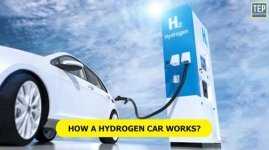 Hydrogen Fuel Cell Vehicles (FCEVs)
Hydrogen Fuel Cell Vehicles (FCEVs)
These are the most common type of hydrogen cars on the road today (e.g., Toyota Mirai, Hyundai Nexo, Honda Clarity Fuel Cell).
How it works:
- Hydrogen Storage
- The car carries compressed hydrogen gas in a high-pressure tank (typically 350–700 bar).
- Fuel Cell Reaction
- Hydrogen enters the fuel cell stack, where it is combined with oxygen from the air.
- In the anode side of the cell, a catalyst splits hydrogen (H₂) into protons (H⁺) and electrons (e⁻).
- Electricity Generation
- Protons pass through a special membrane (PEM – Proton Exchange Membrane).
- Electrons are forced to travel through an external circuit → creating electric current that powers the electric motor.
- Byproduct: Water
- At the cathode, protons, electrons, and oxygen combine to form H₂O (water vapor), which is released through the tailpipe.
- Energy Storage
- A small lithium-ion battery stores electricity for peak power demand (e.g., rapid acceleration) and recaptures energy from regenerative braking.

 Hydrogen Internal Combustion Engine Vehicles (HICEVs)
Hydrogen Internal Combustion Engine Vehicles (HICEVs)
These are less common but under development by manufacturers like Toyota (hydrogen Corolla race car) and BMW.
How it works:
- Modified Gasoline Engine
- A hydrogen ICE looks and works much like a regular petrol or diesel engine.
- The main difference: instead of injecting gasoline, the engine injects hydrogen gas.
- Combustion
- Hydrogen mixes with air inside the cylinder.
- A spark plug ignites the mixture.
- The combustion pushes pistons, producing mechanical power that drives the car.
- Exhaust
- The main byproduct is water vapor.
- However, at high combustion temperatures, small amounts of NOx (nitrogen oxides) can form—so hydrogen ICEs are not zero-emission (unlike fuel cells).
 Fuel Cell vs Hydrogen ICE – Key Differences
Fuel Cell vs Hydrogen ICE – Key Differences
| Feature | Fuel Cell EV (FCEV) | Hydrogen ICE (HICEV) |
|---|---|---|
| Energy Conversion | Electrochemical (no combustion) | Combustion (like petrol engines) |
| Efficiency | ~60% | ~25–30% |
| Emissions | Only water vapor | Mostly water vapor + some NOx |
| Technology maturity | Commercial (Toyota Mirai, Hyundai Nexo) | Prototype / niche (Toyota, BMW) |
| Driving system | Electric motor | Mechanical pistons + drivetrain |
| Smoothness & noise | Silent (like EV) | Noisy (like a normal engine) |
- Fuel cell hydrogen cars (FCEVs) are the cleanest and most efficient use of hydrogen—already sold commercially in small numbers.
- Hydrogen ICEs (HICEVs) are more like a transitional technology: easier to build using existing engines, but less efficient and not fully emission-free.
